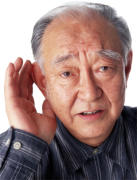

Contact: mriley@earglasses.com Big Ideas Incorporated, 6425 North 75th Drive, Glendale, AZ 85303
To review our Privacy Policy, click here.
Copyright © 2022 by Big Ideas Incorporated
FOR USERS
Who Are They Good For?
1. Baby boomers
At least a third of people over the age of sixty may begin to notice that they have a mild to moderate degree of hearing loss. It usually first becomes noticeable in high frequencies. This age-related condition is referred to by audiologists as “presbycusis.” The degree of loss may be greater for those who were exposed (by choice or vocation) to loud, even painful sound volume levels earlier in their lives.2. Even teenagers
The prestigious Journal of the American Medical Association noted in 2010 that a fifth U.S. teens now have a hearing loss. And the rate at which these losses occur appears to be increasing. By 1994, nearly one in seven, or 14.9% of 12-19 year olds, had a measurable hearing loss. By 2006 this had grown to 19.5%, or nearly one in five teens. The popular use of personal electronic devices with headphones delivering higher than safe volumes is one cause for this epidemic loss.3. Gift Givers
Many people who buy Earglasses® lenses give them as gifts. They often do that to end the “wars for control of the remote control” of a TV set or audio system. The lenses can end disputes about “It’s too loud!” versus “But I can’t hear what they’re saying!” It’s self-protection: buyers don’t like listening at uncomfortable volume levels, so they give their partner Earglasses® lenses gift in self-defense.
Finally, many users (including the inventor of Earglasses® himself) just want to be able
to better enjoy the sonic nuances that more delicate overtones and undertones may
convey. These folks may be audiophiles, or even singers and other musical performers
who want to experience every bit of the beauty that music can inspire. Some users are
world-famous musicians, from classical and jazz artists to pop genre performers.




Earglasses® lenses were designed to fit
around the average-sized adults’ external
ear, or pinna. For those with smaller ears,
each product package contains a pair of
elastic bands used as shown here:
A ”how to” video demonstration can be
seen here;
Whether you need bands or not, the best
way to put on each lens is with both hands.
Use one hand to pull out your pinna, and
use the other to push the lens forward
from the back of your ear to the front. That
will push your pinna forward. The more
your pinna sticks out, the better the results.
Then put the elastic band around the outer
rim of the lens and the front side of your
ear, to help hold the lens in place.
https://youtu.be/x4MydIMqCxA

FREE, FREE, FREE!
If you’d like to download a free .pdf copy of our twenty-four page booklet New Secrets of Better Hearing, click here.

How To Wear Earglasses®


Contact: mriley@earglasses.com Big Ideas Inc., 6425 North 75th Drive, Glendale, AZ 85303
To review our Privacy Policy, click here.
Finally, many users (including the inventor of Earglasses®
himself) just want to be able to better enjoy the sonic nuances
that more delicate overtones and undertones may convey. These
folks may be audiophiles, or even singers and other musical
performers who want to experience every bit of the beauty that
music can inspire. Some users are world-famous musicians, from
classical and jazz artists to pop genre performers.

Who Are They Good For?
1. Baby boomers
At least a third of people over the age of sixty may begin to notice that they have a mild to moderate degree of hearing loss. It usually first becomes noticeable in high frequencies. This age-related condition is referred to by audiologists as “presbycusis.” The degree of loss may be greater for those who were exposed (by choice or vocation) to loud, even painful sound volume levels earlier in their lives.2. Even teenagers
The prestigious Journal of the American Medical Association noted in 2010 that a fifth of U.S. teens now have a hearing loss. And the rate at which these losses occur appears to be increasing. By 1994, nearly one in seven, or 14.9% of 12-19 year olds, had a measurable hearing loss. By 2006 this had grown to 19.5%, or nearly one in five teens. The popular use of personal electronic devices with headphones delivering higher than safe volumes is behind this epidemic loss.3. Gift Givers
Many people who buy a set of Earglasses® lenses give them as gifts. They often do that to end the “wars for control of the remote control” of a TV set or audio system. The lenses can end disputes about “It’s too loud!” versus “But I can’t hear what they’re saying!” Think of it as self-protection: buyers may not want to damage their own hearing by listening to volume levels that might damage their own hearing. So they give their partner an Earglasses® lenses gift in self-defense.FOR USERS

How To Wear Earglasses®
Earglasses® lenses were ergonomically designed to fit around the average sized adults’ external ear, or pinna. For those with smaller ears, each package of the product contains a pair of elastic bands that may be used as shown here:
A ”how to” video demonstration can be seen here;
Whether you need bands or not, the best way to
put on each lens is with both hands. Use one hand
to pull out your pinna, and use the other to push
the lens forward from the back of your ear to the
front. That will push your pinna forward. The more
your pinna sticks out, the better the results. Then
put the elastic band around the outer rim of the
lens and the front side of your ear, to help hold
the lens in place.
FREE, FREE, FREE!
If you’d like to download a free .pdf file copy of our twenty-four page booklet New Secrets of Better Hearing, just click here.



















